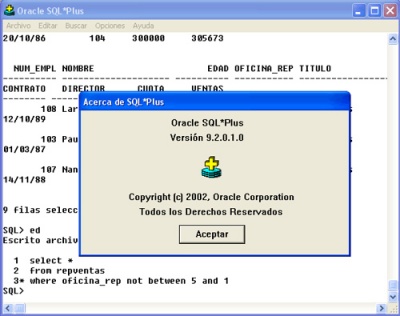SQL*Plus
SQL*Plus is a command line interface to the Oracle Database. From SQL*Plus, one can issue SQL, PL/SQL and special SQL*Plus commands.
SQL*Plus provides a user-friendly interface which allows you to define and manipulate data in an Oracle database. SQL*Plus adheres to all SQL standards and contains some Oracle-specific add-ons. The "Plus" in SQL*Plus refers to an extension of SQL.
Contents
Starting SQL*Plus[edit]
To run SQL*Plus, on Windows choose:
Start > Programs > Oracle - HOME-NAME > Application Development > SQL Plus.
Alternatively, start it from the command line: sqlplus.exe in ORACLE_HOME\bin
Unix/Linux: sqlplus in $ORACLE_HOME/bin
Example:
$ sqlplus SQL*Plus: Release 10.2.0.1.0 - Production on Sun Jul 23 09:42:49 2006 Copyright (c) 1982, 2005, Oracle. All rights reserved. Enter user-name: scott Enter password: Connected to: Oracle Database 10g Enterprise Edition Release 10.2.0.1.0 - Production With the Partitioning, OLAP and Data Mining options SQL>
Leaving SQL*Plus[edit]
Use the "exit" command to terminate your SQL*Plus session.
SQL> exit;
To send a return code back to the operating system:
SQL> exit 10;
Command line parameters[edit]
- Connect to database: userid/password@connectstring
- Start in silent mode: -s
- Execute a script: @scriptname.sql
- Do not log in to a database: /nolog
Example:
$ sqlplus scott/tiger SQL*Plus: Release 11.1.0.6.0 - Production on Sun Oct 21 13:08:36 2007 Copyright (c) 1982, 2007, Oracle. All rights reserved. Connected to: Oracle Database 11g Enterprise Edition Release 11.1.0.6.0 - Production With the Partitioning, OLAP, Data Mining and Real Application Testing options SQL>
SQL*Plus Commands[edit]
EDIT[edit]
Edit the command buffer or a SQL file. Can be abbreviated as "ed".
SQL> ed scriptname.sql
To change the external editor (in this example, use vi).
SQL> DEF _EDITOR=vi
RUN[edit]
Execute the command buffer or execute a SQL file. Can be abbreviated as "@".
SQL> @scriptname.sql
LIST[edit]
List the content of the command buffer.
SQL> l 1* select * from emp
SHOW[edit]
Show all SQL*Plus settings:
SQL> SHOW ALL appinfo is OFF and set to "SQL*Plus" arraysize 15 autocommit OFF autoprint OFF autorecovery OFF autotrace OFF blockterminator "." (hex 2e) btitle OFF and is the first few characters of the next SELECT statement cmdsep OFF colsep " " ...
Show the value for a specific setting:
SQL> SHOW autotrace autotrace OFF
SET[edit]
To change a SQL*Plus setting:
SQL> SET autotrace ON
DEFINE[edit]
See what variables are defined:
SQL> DEFINE DEFINE _DATE = "22-JUL-2006 11:34:34" (CHAR) DEFINE _CONNECT_IDENTIFIER = "o10gr2" (CHAR) DEFINE _USER = "SCOTT" (CHAR) ...
Define a new variable:
SQL> DEFINE var1=123
Undefine a variable:
SQL> UNDEFINE var1
Using a variable in a SELECT statement:
SQL> SELECT * FROM tab1 WHERE col1 = &&var1;
SPOOL[edit]
Spool output to file:
SPOOL myreport.lst ... SPOOL OFF
COPY[edit]
The copy command can be used to copy tables between databases and schemas. Great for copying tables with LONG fields.
Example:
COPY FROM scott/tiger@local_db TO scott/tiger@remote_db - CREATE remote_emp - USING SELECT * FROM emp;
Note: The "-" at the end of each line (except the last) indicates that the command continues on the next line.
CLEAR[edit]
Clear the SQL*Plus screen and the screen buffer. Syntax: CLEAR {BREAKS|BUFFER|COLUMNS|COMPUTES|SCREEN|SQL TIMING}
Example:
CLEAR SCREEN
To clear SQL*Plus screen you can also use ALT+E+R; another shortcut is Shift+Del.
Report formatting[edit]
Columns can be formatted with:
col col_name options values
where options = null, heading, format, print, noprint, clear, etc.
Example:
SQL> col empno heading emp|security|no
SQL> col sal format $09,999.99
SQL> col comm null '-na-'
SQL> col mgr noprint
SQL>
SQL> select * from emp;
emp
security
no ENAME JOB HIREDATE SAL COMM DEPTNO
--------- ---------- --------- --------- ----------- --------- ---------
7369 SMITH CLERK 17-DEC-80 $00,800.00 -na- 20
7499 ALLEN SALESMAN 20-FEB-81 $01,600.00 300 30
7521 WARD SALESMAN 22-FEB-81 $01,250.00 500 30
...
SQL> clear col
columns cleared
SQL> select * from emp;
EMPNO ENAME JOB MGR HIREDATE SAL COMM DEPTNO
-------- ---------- --------- --------- --------- --------- --------- ---------
7369 SMITH CLERK 7902 17-DEC-80 800 20
7499 ALLEN SALESMAN 7698 20-FEB-81 1600 300 30
7521 WARD SALESMAN 7698 22-FEB-81 1250 500 30
...
Similar to this, we have different option for title (tti, bti).

